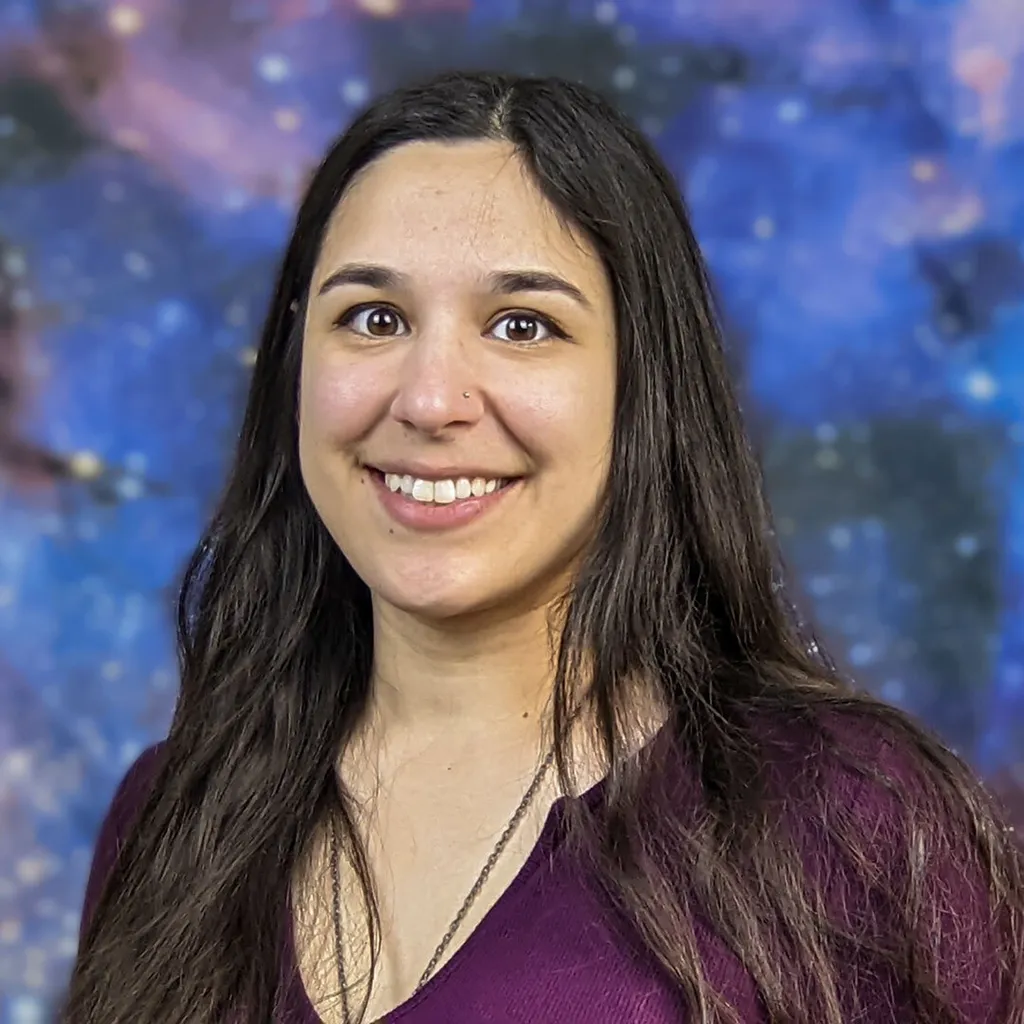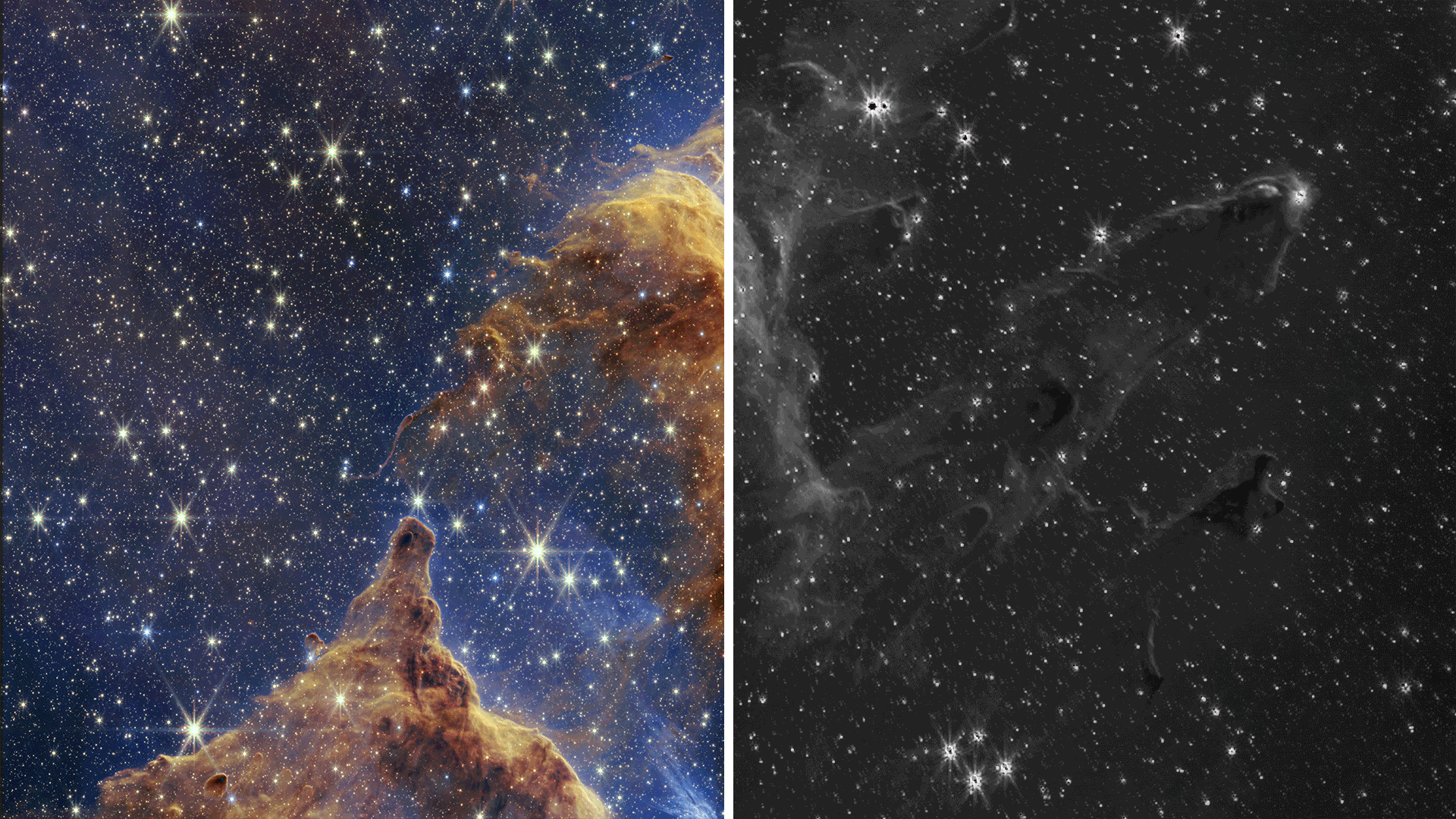- April 03, 2025
- By Emily C. Nunez
Alyssa Pagan ’16 doesn’t remember exactly when or where she first fell in love with the night sky on some cloudless evening in her youth—just the awe she felt at the vast panorama of space.
“It was mind-blowing for me to realize that all those points are stars, and those stars potentially have planets of their own,” she said.

Years later, Pagan does more than just admire the stars. She brings distant worlds to life as a science visuals developer with the Space Telescope Science Institute (STScI), the Baltimore-based organization that operates the Hubble Space Telescope and James Webb Space Telescope (JWST) in partnership with NASA.
Pagan transforms dark, monochromatic images into the dazzling displays of light and color seen on computers, phones and TV screens. Among her greatest hits: the “Cosmic Cliffs” of the Carina Nebula, one of the first JWST images published in 2022; a star-studded view of the “Pillars of Creation,” first popularized by Hubble but revisited nearly three decades later by JWST; and a snapshot of Galaxy NGC 1433, a barred spiral galaxy with young stars forming its swirling “arms.”
Though her job involves some artistic interpretation, Pagan explained that her role is less about “creating” an image and more about chasing away the shadows to bring cosmic marvels into the light.
“I see myself as an art restorer because I'm revealing something that's already there,” Pagan said. “But since it’s my job, I sometimes forget the scale of things, so it's nice to take a step back and realize, ‘This is a deep-field image containing a galaxy that is 300 million years old.’”

Despite taking an early interest in space, Pagan didn’t set out to study science. In 2011, she earned her bachelor’s degree in art and design with a focus on traditional illustration—think “cell by cell, old-school Disney,” Pagan explained—from Towson University. Still, she couldn’t shake the feeling that she should be doing something in the sciences.
After taking community college classes for a while, Pagan transferred to UMD as an astronomy major in 2014. What started as a hunch became the perfect educational blend for her future job at STScI.
“I wasn’t thinking at the time about how my two interests—art and science—would come together,” Pagan said. “I just knew that I enjoyed art and I enjoyed science, so I wanted to learn about both.”
Pagan caught a first glimpse of her future career while taking an observational astronomy class taught by Department of Astronomy Chair and Professor Andrew Harris.
“It’s where I realized that the position I have now—creating images from observatory data—was a thing that people do,” Pagan said. “We took observations of several objects, but the one I remember now is the Ring Nebula. It was cool to realize, ‘I took this data myself of something that exists lightyears away, and I’m able to detect it and show what it looks like.’”

After graduating from UMD in 2016, Pagan stayed in the department and worked as an office clerk and academic program specialist. When she saw an opening for her current position at STScI, she applied with arris’ and the department’s full support.
After joining STScI’s production team in 2019, Pagan primarily processed Hubble images until JWST’s launch in December 2021. As a visualizer, she works with data that has been captured by space telescopes, transmitted to Earth and then calibrated by scientists. At first glance, the resulting image appears black, perhaps with dots representing stars or galaxies. “That's because the sensitivity of these instruments is way beyond the capability of our displays.”
Pagan then “stretches,” or expands, the distribution of brightness values to illuminate any details left in the dark.
“We transform that data so that we can actually see this huge range of details and reveal stuff that's near the dark end, which is where a lot of the cool stuff can be found,” Pagan said.
From there, Pagan uses photo editing software to layer images and assign colors to different features. Because JWST observes the universe in infrared—light beyond the spectrum that human eyes can see—Pagan uses a technique called chromatic ordering to assign visible colors based on the wavelengths of infrared light. For instance, shorter wavelengths are assigned shades of blue, and longer ones appear in red.
She also adds color to emphasize details or distinguish between physical features like space dust and swirling gases.
“I think it's important for people to understand that we present these images so that people can understand them,” Pagan said. “Since they are infrared imagery, there has to be some level of interpretation, but we are basing it on science as best as possible.”
Participating in a project as “grand” as JWST, the world’s most powerful telescope, has been an exciting challenge for Pagan.
“Webb had been over 25 years in the making,” Pagan said. “The fact that it works and I get to put out an image showing what it sees—it’s powerful.”
While observations from JWST will continue to contribute to Pagan’s work, STScI is gearing up for its next big mission: NASA’s Nancy Grace Roman Space Telescope, set to launch by May 2027 to investigate exoplanets, dark matter and energy, and other mysteries of the universe.
Topics
People